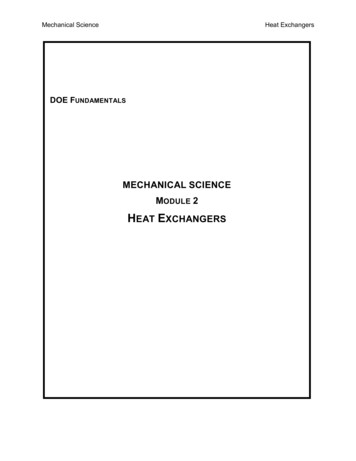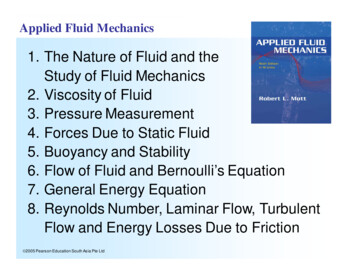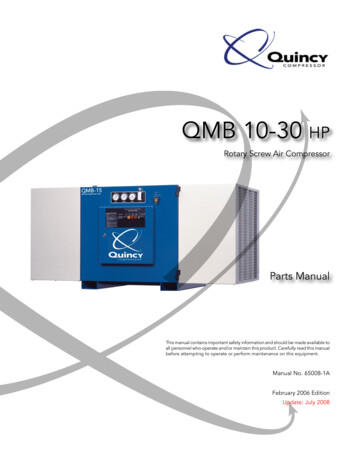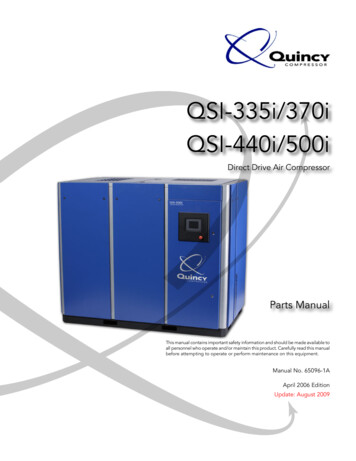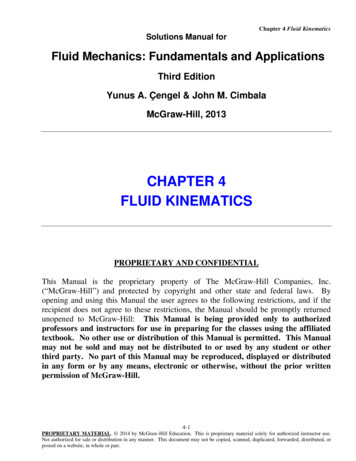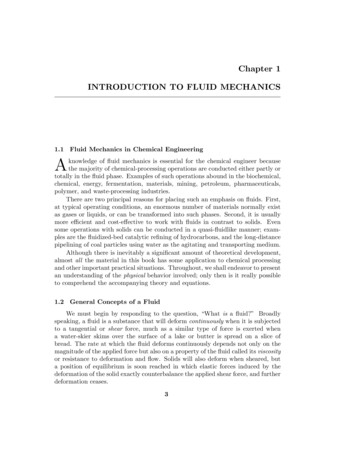
Transcription
Chapter 1INTRODUCTION TO FLUID MECHANICS1.1 Fluid Mechanics in Chemical EngineeringAknowledge of fluid mechanics is essential for the chemical engineer becausethe majority of chemical-processing operations are conducted either partly ortotally in the fluid phase. Examples of such operations abound in the biochemical,chemical, energy, fermentation, materials, mining, petroleum, pharmaceuticals,polymer, and waste-processing industries.There are two principal reasons for placing such an emphasis on fluids. First,at typical operating conditions, an enormous number of materials normally existas gases or liquids, or can be transformed into such phases. Second, it is usuallymore efficient and cost-effective to work with fluids in contrast to solids. Evensome operations with solids can be conducted in a quasi-fluidlike manner; examples are the fluidized-bed catalytic refining of hydrocarbons, and the long-distancepipelining of coal particles using water as the agitating and transporting medium.Although there is inevitably a significant amount of theoretical development,almost all the material in this book has some application to chemical processingand other important practical situations. Throughout, we shall endeavor to presentan understanding of the physical behavior involved; only then is it really possibleto comprehend the accompanying theory and equations.1.2 General Concepts of a FluidWe must begin by responding to the question, “What is a fluid?” Broadlyspeaking, a fluid is a substance that will deform continuously when it is subjectedto a tangential or shear force, much as a similar type of force is exerted whena water-skier skims over the surface of a lake or butter is spread on a slice ofbread. The rate at which the fluid deforms continuously depends not only on themagnitude of the applied force but also on a property of the fluid called its viscosityor resistance to deformation and flow. Solids will also deform when sheared, buta position of equilibrium is soon reached in which elastic forces induced by thedeformation of the solid exactly counterbalance the applied shear force, and furtherdeformation ceases.3
4Chapter 1—Introduction to Fluid MechanicsA simple apparatus for shearing a fluid is shown in Fig. 1.1. The fluid iscontained between two concentric cylinders; the outer cylinder is stationary, andthe inner one (of radius R) is rotated steadily with an angular velocity ω. Thisshearing motion of a fluid can continue indefinitely, provided that a source ofenergy—supplied by means of a torque here—is available for rotating the innercylinder. The diagram also shows the resulting velocity profile; note that thevelocity in the direction of rotation varies from the peripheral velocity Rω of theinner cylinder down to zero at the outer stationary cylinder, these representingtypical no-slip conditions at both locations. However, if the intervening spaceis filled with a solid—even one with obvious elasticity, such as rubber—only alimited rotation will be possible before a position of equilibrium is reached, unless,of course, the torque is so high that slip occurs between the rubber and the nderAVelocityprofileARωFluidFixedcylinder(a) Side elevationFluidRω(b) Plan of section across A-A (not to scale)Fig. 1.1 Shearing of a fluid.There are various classes of fluids. Those that behave according to nice and obvious simple laws, such as water, oil, and air, are generally called Newtonian fluids.These fluids exhibit constant viscosity but, under typical processing conditions,virtually no elasticity. Fortunately, a very large number of fluids of interest to thechemical engineer exhibit Newtonian behavior, which will be assumed throughoutthe book, except in Chapter 11, which is devoted to the study of non-Newtonianfluids.A fluid whose viscosity is not constant (but depends, for example, on theintensity to which it is being sheared), or which exhibits significant elasticity, istermed non-Newtonian. For example, several polymeric materials subject to deformation can “remember” their recent molecular configurations, and in attemptingto recover their recent states, they will exhibit elasticity in addition to viscosity.Other fluids, such as drilling mud and toothpaste, behave essentially as solids and
1.3—Stresses, Pressure, Velocity, and the Basic Laws5will not flow when subject to small shear forces, but will flow readily under theinfluence of high shear forces.Fluids can also be broadly classified into two main categories—liquids andgases. Liquids are characterized by relatively high densities and viscosities, withmolecules close together; their volumes tend to remain constant, roughly independent of pressure, temperature, or the size of the vessels containing them. Gases,on the other hand, have relatively low densities and viscosities, with moleculesfar apart; generally, they will rapidly tend to fill the container in which they areplaced. However, these two states—liquid and gaseous—represent but the twoextreme ends of a continuous spectrum of possibilities.PVaporpressurecurve CL G TFig. 1.2 When does a liquid become a gas?The situation is readily illustrated by considering a fluid that is initially a gasat point G on the pressure/temperature diagram shown in Fig. 1.2. By increasingthe pressure, and perhaps lowering the temperature, the vapor-pressure curve issoon reached and crossed, and the fluid condenses and apparently becomes a liquidat point L. By continuously adjusting the pressure and temperature so that theclockwise path is followed, and circumnavigating the critical point C in the process,the fluid is returned to G, where it is presumably once more a gas. But where doesthe transition from liquid at L to gas at G occur? The answer is at no single point,but rather that the change is a continuous and gradual one, through a wholespectrum of intermediate states.1.3 Stresses, Pressure, Velocity, and the Basic LawsStresses. The concept of a force should be readily apparent. In fluid mechanics, a force per unit area, called a stress, is usually found to be a more convenientand versatile quantity than the force itself. Further, when considering a specificsurface, there are two types of stresses that are particularly important.1. The first type of stress, shown in Fig. 1.3(a), acts perpendicularly to thesurface and is therefore called a normal stress; it will be tensile or compressive,depending on whether it tends to stretch or to compress the fluid on which it acts.The normal stress equals F/A, where F is the normal force and A is the area ofthe surface on which it acts. The dotted outlines show the volume changes caused
6Chapter 1—Introduction to Fluid Mechanicsby deformation. In fluid mechanics, pressure is usually the most important typeof compressive stress, and will shortly be discussed in more detail.2. The second type of stress, shown in Fig. 1.3(b), acts tangentially to thesurface; it is called a shear stress τ , and equals F/A, where F is the tangentialforce and A is the area on which it acts. Shear stress is transmitted through afluid by interaction of the molecules with one another. A knowledge of the shearstress is very important when studying the flow of viscous Newtonian fluids. Fora given rate of deformation, measured by the time derivative dγ/dt of the smallangle of deformation γ, the shear stress τ is directly proportional to the viscosityof the fluid (see Fig. 1.3(b)).FFArea AFFFig. 1.3(a) Tensile and compressive normal stresses F/A, acting on a cylinder, causing elongation and shrinkage, ea AFFig. 1.3(b) Shear stress τ F/A, acting on a rectangularparallelepiped, shown in cross section, causing a deformationmeasured by the angle γ (whose magnitude is exaggerated here).Pressure. In virtually all hydrostatic situations—those involving fluids atrest—the fluid molecules are in a state of compression. For example, for theswimming pool whose cross section is depicted in Fig. 1.4, this compression at atypical point P is caused by the downwards gravitational weight of the water abovepoint P. The degree of compression is measured by a scalar, p—the pressure.A small inflated spherical balloon pulled down from the surface and tetheredat the bottom by a weight will still retain its spherical shape (apart from a smalldistortion at the point of the tether), but will be diminished in size, as in Fig.1.4(a). It is apparent that there must be forces acting normally inward on the
1.3—Stresses, Pressure, Velocity, and the Basic Laws7surface of the balloon, and that these must essentially be uniform for the shape toremain spherical, as in Fig. 1.4(b).WaterBalloonSurfaceBalloonWater P(b)(a)Fig. 1.4 (a) Balloon submerged in a swimming pool; (b) enlargedview of the compressed balloon, with pressure forces acting on it.Although the pressure p is a scalar, it typically appears in tandem with an areaA (assumed small enough so that the pressure is uniform over it). By definitionof pressure, the surface experiences a normal compressive force F pA. Thus,pressure has units of a force per unit area—the same as a stress.The value of the pressure at a point is independent of the orientation of anyarea associated with it, as can be deduced with reference to a differentially smallwedge-shaped element of the fluid, shown in Fig. 1.5.π θ2zpA dAdAdCθypC dCdBxp B dBFig. 1.5 Equilibrium of a wedge of fluid.Due to the pressure there are three forces, pA dA, pB dB, and pC dC, that acton the three rectangular faces of areas dA, dB, and dC. Since the wedge is notmoving, equate the two forces acting on it in the horizontal or x direction, notingthat pA dA must be resolved through an angle (π/2 θ) by multiplying it bycos(π/2 θ) sin θ:pA dA sin θ pC dC.(1.1)The vertical force pB dB acting on the bottom surface is omitted from Eqn. (1.1)because it has no component in the x direction. The horizontal pressure forces
8Chapter 1—Introduction to Fluid Mechanicsacting in the y direction on the two triangular faces of the wedge are also omitted, since again these forces have no effect in the x direction. From geometricalconsiderations, areas dA and dC are related by:dC dA sin θ.(1.2)p A pC ,(1.3)These last two equations yield:verifying that the pressure is independent of the orientation of the surface beingconsidered. A force balance in the z direction leads to a similar result, pA pB .1For moving fluids, the normal stresses include both a pressure and extrastresses caused by the motion of the fluid, as discussed in detail in Section 5.6.The amount by which a certain pressure exceeds that of the atmosphere istermed the gauge pressure, the reason being that many common pressure gaugesare really differential instruments, reading the difference between a required pressure and that of the surrounding atmosphere. Absolute pressure equals the gaugepressure plus the atmospheric pressure.Velocity. Many problems in fluid mechanics deal with the velocity of thefluid at a point, equal to the rate of change of the position of a fluid particlewith time, thus having both a magnitude and a direction. In some situations,particularly those treated from the macroscopic viewpoint, as in Chapters 2, 3,and 4, it sometimes suffices to ignore variations of the velocity with position.In other cases—particularly those treated from the microscopic viewpoint, as inChapter 6 and later—it is invariably essential to consider variations of velocitywith position.Au(a)Au(b)Fig. 1.6 Fluid passing through an area A:(a) Uniform velocity, (b) varying velocity.Velocity is not only important in its own right, but leads immediately to threefluxes or flow rates. Specifically, if u denotes a uniform velocity (not varying withposition):1Actually, a force balance in the z direction demands that the gravitational weight of the wedge be considered,which is proportional to the volume of the wedge. However, the pressure forces are proportional to theareas of the faces. It can readily be shown that the volume-to-area effect becomes vanishingly small as thewedge becomes infinitesimally small, so that the gravitational weight is inconsequential.
1.3—Stresses, Pressure, Velocity, and the Basic Laws91. If the fluid passes through a plane of area A normal to the direction of thevelocity, as shown in Fig. 1.6, the corresponding volumetric flow rate of fluidthrough the plane is Q uA.2. The corresponding mass flow rate is m ρQ ρuA, where ρ is the (constant)fluid density. The alternative notation with an overdot, ṁ, is also used.3. When velocity is multiplied by mass it gives momentum, a quantity of primeimportance in fluid mechanics. The corresponding momentum flow rate passing through the area A is Ṁ mu ρu2 A.If u and/or ρ should vary with position, as in Fig. 1.6(b), the correspondingex pressions will be seen later to involve integrals over the area A: Q A u dA, m ρu dA, Ṁ A ρu2 dA.ABasic laws. In principle, the laws of fluid mechanics can be stated simply,and—in the absence of relativistic effects—amount to conservation of mass, energy,and momentum. When applying these laws, the procedure is first to identifya system, its boundary, and its surroundings; and second, to identify how thesystem interacts with its surroundings. Refer to Fig. 1.7 and let the quantity Xrepresent either mass, energy, or momentum. Also recognize that X may be addedfrom the surroundings and transported into the system by an amount Xin acrossthe boundary, and may likewise be removed or transported out of the system tothe surroundings by an amount Xout .X inSystemBoundaryX createdX destroyedSurroundingsX outFig. 1.7 A system and transports to and from it.The general conservation law gives the increase ΔXsystem in the X-content ofthe system as:Xin Xout ΔXsystem .(1.4a)Although this basic law may appear intuitively obvious, it applies only to avery restricted selection of properties X. For example, it is not generally true if Xis another extensive property such as volume, and is quite meaningless if X is anintensive property such as pressure or temperature.In certain cases, where X i is the mass of a definite chemical species i , we mayiialso have an amount of creation Xcreatedor destruction Xdestroyeddue to chemicalreaction, in which case the general law becomes:iiiiiXin Xout Xcreated Xdestroyed ΔXsystem.(1.4b)
10Chapter 1—Introduction to Fluid MechanicsThe conservation law will be discussed further in Section 2.1, and is of such fundamental importance that in various guises it will find numerous applicationsthroughout all of this text.To solve a physical problem, the following information concerning the fluid isalso usually needed:1. The physical properties of the fluid involved, as discussed in Section 1.4.2. For situations involving fluid flow , a constitutive equation for the fluid, whichrelates the various stresses to the flow pattern.1.4 Physical Properties—Density, Viscosity, and Surface TensionThere are three physical properties of fluids that are particularly important:density, viscosity, and surface tension. Each of these will be defined and viewedbriefly in terms of molecular concepts, and their dimensions will be examined interms of mass, length, and time (M, L, and T). The physical properties dependprimarily on the particular fluid. For liquids, viscosity also depends strongly onthe temperature; for gases, viscosity is approximately proportional to the squareroot of the absolute temperature. The density of gases depends almost directlyon the absolute pressure; for most other cases, the effect of pressure on physicalproperties can be disregarded.Typical processes often run almost isothermally, and in these cases the effectof temperature can be ignored. Except in certain special cases, such as the flow ofa compressible gas (in which the density is not constant) or a liquid under a veryhigh shear rate (in which viscous dissipation can cause significant internal heating),or situations involving exothermic or endothermic reactions, we shall ignore anyvariation of physical properties with pressure and temperature.Densities of liquids. Density depends on the mass of an individual moleculeand the number of such molecules that occupy a unit of volume. For liquids,density depends primarily on the particular liquid and, to a much smaller extent,on its temperature. Representative densities of liquids are given in Table 1.1.2(See Eqns. (1.9)–(1.11) for an explanation of the specific gravity and coefficient ofthermal expansion columns.) The accuracy of the values given in Tables 1.1–1.6is adequate for the calculations needed in this text. However, if highly accuratevalues are needed, particularly at extreme conditions, then specialized informationshould be sought elsewhere.Density. The density ρ of a fluid is defined as its mass per unit volume, andindicates its inertia or resistance to an accelerating force. Thus:ρ 2massM[ ] 3 ,volumeL(1.5)The values given in Tables 1.1, 1.3, 1.4, 1.5, and 1.6 are based on information given in J.H. Perry, ed.,Chemical Engineers’ Handbook, 3rd ed., McGraw-Hill, New York, 1950.
1.4—Physical Properties—Density, Viscosity, and Surface Tension11in which the notation “[ ]” is consistently used to indicate the dimensions of aquantity.3 It is usually understood in Eqn. (1.5) that the volume is chosen so thatit is neither so small that it has no chance of containing a representative selectionof molecules nor so large that (in the case of gases) changes of pressure causesignificant changes of density throughout the volume. A medium characterizedby a density is called a continuum, and follows the classical laws of mechanics—including Newton’s law of motion, as described in this book.Table 1.1 Specific Gravities, Densities, andThermal Expansion Coefficients of Liquids at 20 CLiquidAcetoneBenzeneCrude oil, 35 -PentaneWaterSp. Gr.s0.7920.8790.8510.7891.26 (50 C)0.81913.550.7920.7030.6300.998Density, ρkg/m3lbm 53.149.378.751.1845.949.443.939.362.3αC 1 120—0.001610.000207Degrees A.P.I. (American Petroleum Institute) are related to specific gravity sby the formula:141.5 A.P.I. 131.5.(1.6)sNote that for water, A.P.I. 10, with correspondingly higher values for liquidsthat are less dense. Thus, for the crude oil listed in Table 1.1, Eqn. (1.6) indeed.gives 141.5/0.851 131.5 35 A.P.I.Densities of gases. For ideal gases, pV nRT , where p is the absolutepressure, V is the volume of the gas, n is the number of moles (abbreviated as “mol”when used as a unit), R is the gas constant, and T is the absolute temperature. IfMw is the molecular weight of the gas, it follows that:nMwMw pρ .(1.7)VRT3An early appearance of the notation “[ ]” is in R.B. Bird, W.E. Stewart, and E.N. Lightfoot, TransportPhenomena, Wiley, New York, 1960.
12Chapter 1—Introduction to Fluid MechanicsThus, the density of an ideal gas depends on the molecular weight, absolute pressure, and absolute temperature. Values of the gas constant R are given in Table1.2 for various systems of units. Note that degrees Kelvin, formerly representedby “ K,” is now more simply denoted as “K.”Table 1.2 Values of the Gas Constant, sJ/g-mol Kliter bar/g-mol Kliter atm/g-mol Kcal/g-mol Kpsia ft3 /lb-mol Rft3 atm/lb-mol Rft lbf /lb-mol RFor a nonideal gas, the compressibility factor Z (a function of p and T ) isintroduced into the denominator of Eqn. (1.7), giving:ρ nMwMw p .VZRT(1.8)Thus, the extent to which Z deviates from unity gives a measure of the nonidealityof the gas.The isothermal compressibility of a gas is defined as: 1 V,β V p Tand equals—at constant temperature—the fractional decrease in volume causedby a unit increase in the pressure. For an ideal gas, β 1/p, the reciprocal of theabsolute pressure.The coefficient of thermal expansion α of a material is its isobaric (constantpressure) fractional increase in volume per unit rise in temperature: 1 Vα .(1.9)V T pSince, for a given mass, density is inversely proportional to volume, it follows thatfor moderate temperature ranges (over which α is essentially constant) the densityof most liquids is approximately a linear function of temperature:.ρ ρ0 [1 α(T T0 )],(1.10)
1.4—Physical Properties—Density, Viscosity, and Surface Tension13where ρ0 is the density at a reference temperature T0 . For an ideal gas, α 1/T ,the reciprocal of the absolute temperature.The specific gravity s of a fluid is the ratio of the density ρ to the density ρSCof a reference fluid at some standard condition:ρs .(1.11)ρSCFor liquids, ρSC is usually the density of water at 4 C, which equals 1.000 g/mlor 1,000 kg/m3 . For gases, ρSC is sometimes taken as the density of air at 60 Fand 14.7 psia, which is approximately 0.0759 lbm /ft3 , and sometimes at 0 C andone atmosphere absolute; since there is no single standard for gases, care mustobviously be taken when interpreting published values. For natural gas, consistingprimarily of methane and other hydrocarbons, the gas gravity is defined as theratio of the molecular weight of the gas to that of air (28.8 lbm /lb-mol).Values of the molecular weight Mw are listed in Table 1.3 for several commonlyoccurring gases, together with their densities at standard conditions of atmosphericpressure and 0 C.Table 1.3 Gas Molecular Weights and Densities(the Latter at Atmospheric Pressure and 0 C)GasAirCarbon 44.028.02.016.028.032.0Standard Densitykg/m3lbm 800.00560.04460.07800.0891Viscosity. The viscosity of a fluid measures its resistance to flow under anapplied shear stress, as shown in Fig. 1.8(a). There, the fluid is ideally supposedto be confined in a relatively small gap of thickness h between one plate that isstationary and another plate that is moving steadily at a velocity V relative to thefirst plate.In practice, the situation would essentially be realized by a fluid occupyingthe space between two concentric cylinders of large radii rotating relative to eachother, as in Fig. 1.1. A steady force F to the right is applied to the upper plate(and, to preserve equilibrium, to the left on the lower plate) in order to maintain a
14Chapter 1—Introduction to Fluid Mechanicsconstant motion and to overcome the viscous friction caused by layers of moleculessliding over one another.Velocity VMovingplateMoving plate u VForce FhVelocityprofileyFluidFixedplateFixed plateForce F(a)(b)u yVhFig. 1.8 (a) Fluid in shear between parallelplates; (b) the ensuing linear velocity profile.Under these circumstances, the velocity u of the fluid to the right is foundexperimentally to vary linearly from zero at the lower plate (y 0) to V itselfat the upper plate, as in Fig. 1.8(b), corresponding to no-slip conditions at eachplate. At any intermediate distance y from the lower plate, the velocity is simply:u yV.h(1.12)Recall that the shear stress τ is the tangential applied force F per unit area:τ F,A(1.13)in which A is the area of each plate. Experimentally, for a large class of materials,called Newtonian fluids, the shear stress is directly proportional to the velocitygradient:Vdu μ .(1.14)τ μdyhThe proportionality constant μ is called the viscosity of the fluid; its dimensionscan be found by substituting those for F (ML/T2 ), A (L2 ), and du/dy (T 1 ),giving:Mμ [ ].(1.15)LTRepresentative units for viscosity are g/cm s (also known as poise, designatedby P), kg/m s, and lbm /ft hr. The centipoise (cP), one hundredth of a poise,is also a convenient unit, since the viscosity of water at room temperature isapproximately 0.01 P or 1.0 cP. Table 1.11 gives viscosity conversion factors.The viscosity of a fluid may be determined by observing the pressure drop whenit flows at a known rate in a tube, as analyzed in Section 3.2. More sophisticated
1.4—Physical Properties—Density, Viscosity, and Surface Tension15methods for determining the rheological or flow properties of fluids—includingviscosity—are also discussed in Chapter 11; such methods often involve containingthe fluid in a small gap between two surfaces, moving one of the surfaces, andmeasuring the force needed to maintain the other surface stationary.Table 1.4 Viscosity Parameters for LiquidsLiquidabab(T in R)(T in K)AcetoneBenzeneCrude oil, 35 .76 2.77 3.95 9.01 5.53 17.60 5.72 3.99 3.25 2.62 32.88 2.77 3.95 9.01 5.53 17.60 5.72 3.99 3.25 2.62 5.24The kinematic viscosity ν is the ratio of the viscosity to the density:ν μ,ρ(1.16)and is important in cases in which significant viscous and gravitational forcescoexist. The reader can check that the dimensions of ν are L2 /T, which areidentical to those for the diffusion coefficient D in mass transfer and for the thermaldiffusivity α k/ρcp in heat transfer. There is a definite analogy among the threequantities—indeed, as seen later, the value of the kinematic viscosity governs therate of “diffusion” of momentum in the laminar and turbulent flow of fluids.Viscosities of liquids. The viscosities μ of liquids generally vary approximatelywith absolute temperature T according to:.ln μ a b ln Tor.μ ea b ln T ,(1.17)and—to a good approximation—are independent of pressure. Assuming that μ ismeasured in centipoise and that T is either in degrees Kelvin or Rankine, appropriate parameters a and b are given in Table 1.4 for several representative liquids.The resulting values for viscosity are approximate, suitable for a first design only.
16Chapter 1—Introduction to Fluid MechanicsViscosities of gases. The viscosity μ of many gases is approximated by theformula: nT.μ μ0,(1.18)T0in which T is the absolute temperature (Kelvin or Rankine), μ0 is the viscosity atan absolute reference temperature T0 , and n is an empirical exponent that bestfits the experimental data. The values of the parameters μ0 and n for atmosphericpressure are given in Table 1.5; recall that to a first approximation, the viscosityof a gas is independent of pressure. The values μ0 are given in centipoise and.correspond to a reference temperature of T0 273 K 492 R.Table 1.5 Viscosity Parameters for GasesGasμ0 , cPnAirCarbon 20.6950.8730.7560.814Surface tension.4 Surface tension is the tendency of the surface of a liquid tobehave like a stretched elastic membrane. There is a natural tendency for liquidsto minimize their surface area. The obvious case is that of a liquid droplet on ahorizontal surface that is not wetted by the liquid—mercury on glass, or water ona surface that also has a thin oil film on it. For small droplets, such as those onthe left of Fig. 1.9, the droplet adopts a shape that is almost perfectly spherical,because in this configuration there is the least surface area for a given volume.Fig. 1.9 The larger droplets are flatter because gravity is becoming more important than surface tension.4We recommend that this subsection be omitted at a first reading, because the concept of surface tension issomewhat involved and is relevant only to a small part of this book.
1.4—Physical Properties—Density, Viscosity, and Surface Tension17For larger droplets, the shape becomes somewhat flatter because of the increasinglyimportant gravitational effect, which is roughly proportional to a3 , where a is theapproximate droplet radius, whereas the surface area is proportional only to a2 .Thus, the ratio of gravitational to surface tension effects depends roughly on thevalue of a3 /a2 a, and is therefore increasingly important for the larger droplets,as shown to the right in Fig. 1.9. Overall, the situation is very similar to that ofa water-filled balloon, in which the water accounts for the gravitational effect andthe balloon acts like the surface tension.A fundamental property is the surface energy, which is defined with referenceto Fig. 1.10(a). A molecule I, situated in the interior of the liquid, is attractedequally in all directions by its neighbors. However, a molecule S, situated inthe surface, experiences a net attractive force into the bulk of the liquid. (Thevapor above the surface, being comparatively rarefied, exerts a negligible force onmolecule S.) Therefore, work has to be done against such a force in bringing aninterior molecule to the surface. Hence, an energy σ, called the surface energy, canbe attributed to a unit area of the surface.Molecule SFreesurfaceLiquidMolecule IWTNewlycreatedsurfaceTL(a)(b)Fig. 1.10 (a) Molecules in the interior and surface of a liquid; (b) newlycreated surface caused by moving the tension T through a distance L.An equivalent viewpoint is to consider the surface tension T existing per unitdistance of a line drawn in the surface, as shown in Fig. 1.10(b). Suppose that sucha tension has moved a distance L, thereby creating an area W L of fresh surface.The work done is the product of the force, T W , and the distance L through whichit moves, namely T W L, and this must equal the newly acquired surface energyσW L. Therefore, T σ; both quantities have units of force per unit distance,such as N/m, which is equivalent to energy per unit area, such as J/m2 .We next find the amount p1 p2 by which the pressure p1 inside a liquid dropletof radius r, shown in Fig. 1.11(a), exceeds the pressure p2 of the surrounding vapor.Fig. 1.11(b) illustrates the equilibrium of the upper hemisphere of the droplet,which is also surrounded by an imaginary cylindrical “control surface” ABCD,on which forces in the vertical direction will soon be equated. Observe that the
18Chapter 1—Introduction to Fluid Mechanicsinternal pressure p1 is trying to blow apart the two hemispheres (the lower one isnot
6 Chapter 1—Introduction to Fluid Mechanics by deformation. In fluid mechanics, pressure is usually the most important type of compressive stress, and will shortly be discussed in more detail. 2. The second type of stress, shown in Fig. 1.3(b), acts tangentially to the surface; it is called a shear stress τ, and equals F/A, where F is the tangential force and A is the area on which it acts.






